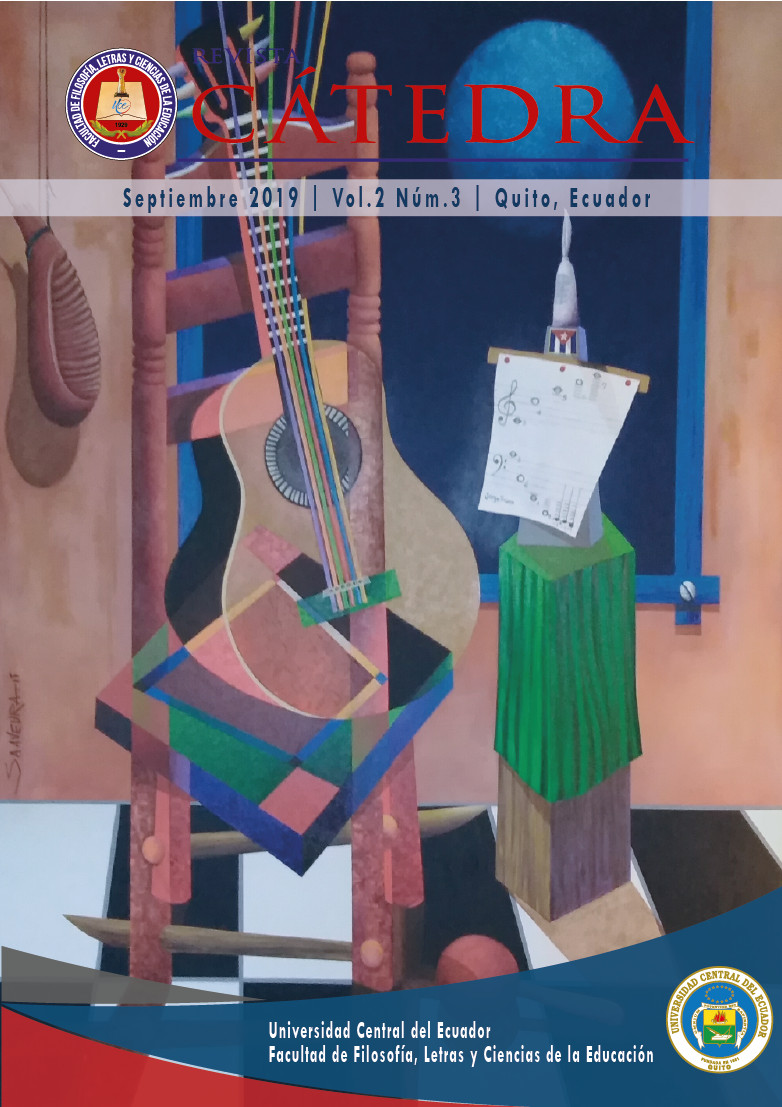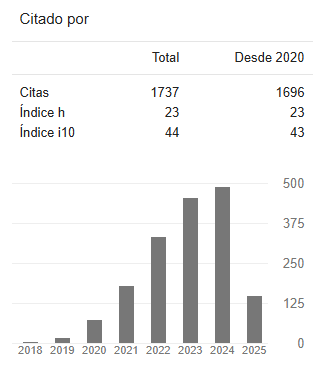Social networks in universities of the country: Descriptive analysis and approach to a possible solution to improve the impact on academic activity
DOI:
https://doi.org/10.29166/catedra.v2i3.1713Keywords:
social networks, engagement, academy, leisure, conversational channelsAbstract
This manuscript aimed to examine the use made by university students to social networks and the position held by educational centers when incorporating such means to their academic plan, being the latter the objective of this study in order to analyze the data based on publications taken from FanPages of three universities in Quito, in addition to comments and reactions by users of such releases. Comparison between the use for academic purposes and for leisure is the main parameters considered, and results were shown trough graphics and statistics. Based on such analysis, a possible resource was proposed, based on chatbots technology in order to generate more commitment and loyalty by university students to educational establishment.
It was found that students use social networks to generate experiences and feelings, for which an interaction is generated mostly with leisure websites in comparison to academic ones, where a great amount of words and publications are found, allowing to identify themselves and become a follower, whose main characteristics is share, comment and react with most of the postings.
Downloads
References
Achen, R. (2016). Examining the Influence of Facebook Fans, Content, and Engagement on Business Outcomes in the National Basketball Association. Journal of Social Media for Organizations, 3(1), 1-15. Obtenido de http://www2.mitre.org/public/jsmo/pdfs/03-01-nba-business-outcomes.pdf
Anaza, N., & Zhao, J. (2013). Encounter-based antecedents of e-customer citizenship behaviors. (E. G. Limited, Ed.) Journal of Services Marketing, 130-140. doi:http://dx.doi.org/10.1108/08876041311309252
Antolín Prieto, R. (2012). Youtube como paradigma del video y la telvisión en la web 2.0. Madrid: Universidad Complutense de Madrid. Obtenido de http://eprints.ucm.es/16111/
Brahimi, T., & Sarirete, A. (2015). Learning outside the classroom through MOOCs. Computers in Human Behavior, 51, 604–609. doi:10.1016/j.chb.2015.03.013
Bustos, A., Flores, B., & Flores, F. (2016). Las redes sociales, su influencia e incidencia en el rendimiento académico de los estudiantes de una entidad educativa ecuatoriana en las asignaturas de Física y Matemática. Latin-American Journal of Physics Education, 10(1), 1-7. Obtenido de https://dialnet.unirioja.es/servlet/oaiart?codigo=5517259
Calder, B., Malthouse, E., & Schaedel, U. (2009). An experimental study of the relationship between online engagement and advertising effectiveness. Journal of Interactive Marketing, 23(4), 321-331. doi:10.1016/j.intmar.2009.07.002.
Ciechanowski, L., Przegalinska, A., Magnuski, M., & Gloor, P. (2018). In the shades of the uncanny valley: An experimental study of human–chatbot interaction. Future Generation Computer Systems, 1-10. doi:10.1016/j.future.2018.01.055
Dakiche, N., Benbouzid-Si, F., Slimani, Y., & Karima, B. (2018). Tracking community evolution in social networks: A survey,. Information Processing & Management. doi:10.1016/j.ipm.2018.03.005.
Erat, P., Desouza, K., Schäfer-Jugel, A., & Kurzawa, M. (2006). Business Customer Communities and Knowledge Sharing: Exploratory Study of Critical Issues. European Journal of Information Systems. (P. Macmillan, Ed.) European Journal of Information Systems, 15(5), 511-524. doi:10.1057/palgrave.ejis.3000643
Espuny, C., González, J., Mar, L., & Gisbert, M. (2011). Actitudes y expectativas del uso educativo de las redes sociales en los alumnos universitarios. RUSC. Universities and Knowledge Society Journal, 171-185. Obtenido de http://www.redalyc.org/articulo.oa?id=78017126008
Gómez, M., Roses, S., & Farias, P. (2012). El uso académico de las redes sociales en universitarios. Comunicar, 131-138. doi:10.3916/C38-2012-03-04
Gonzales, A. L., & Hancock, J. (2010). Mirror, Mirror on My Facebook Wall: Effects of Exposure to Facebook on Self-Esteem. Cyberpsychology, Behavior, and Social Networking, 79-83. doi:10.1089/cyber.2009.0411
Gordon Salcedo, E. D., & Noguera Vásconez, D. F. (2018). Estudio de los comportamientos y expectativas del uso de las rerdes sociales en las pincipales universidades del país y planteamiento de una posible solución para un mejor impacto en la actividad académica (Bachelor's thesis, Quito: UCE)
Herrera, D., Valerio, G., & Rodríguez-Aceves, L. (2018). Digital engagement and social identity of sports fans: the case of Premier League teams on facebook. Revista Iberoamericana de Psicología del Ejercicio y el Deporte, 13(1), 59-69. Obtenido de http://www.redalyc.org/articulo.oa?id=311153534006
Herrera-Torres L., Pérez-Tur F., García-Fernández J., Fernández-Gavira J. (2017). El uso de las redes sociales y el engagement de los clubes de la Liga Endesa ACB. Cuadernos De Psicologia Del Deporte, 17(3), 175-182. Obtenido de http://www.redalyc.org/articulo.oa?id=227053840017
Huang, C. (2018). Social network site use and academic achievement: A meta-analysis. Computers & Education, 119, 76-83. doi:10.1016/j.compedu.2017.12.010.
Junco, R. (2012). Too much face and not enough books: The relationship between multiple indices of Facebook use and academic performance. Computers in Human Behavior, 28(1), 187-198. doi:10.1016/j.chb.2011.08.026
Kim, J., Jin, B., & Swinney, J. (2009). The role of etail quality, e-satisfaction and e-trust in online loyalty development process. Journal of Retailing and Consumer Services, 16(4), 239-247. doi:10.1016/j.jretconser.2008.11.019
Kudeshia, C., Mittal, A., & Sikdar, P. (2016). Spreading love through fan page liking: A perspective on small scale entrepreneurs. Computers in Human Behavior, 54, 257-270. doi:10.1016/j.chb.2015.08.003
Kuz, A., Falco, M., Giandini, R., & Nahuel, L. (2015). Integrando Redes Sociales y Técnicas de Inteligencia Artificial en Entornos Educativos. Revista Q, 10(19), 1-9. doi:10.18566/revistaq.v10n19.a04
Leskovec, J., Lang, K., Dasgupta, A., & Mahoney, M. (2008). Statistical properties of community structure in large social and information networks. 695-704 . doi:10.1145/1367497.1367591
Martelo, R., Jimenez-Pitre, I. 2., & Martelo, P. (2017). Incidencia de las redes sociales en el rendimiento académico de los estudiantes de la universidad de La Guajira (Colombia). Revista Espacios, 38(45), 24. Obtenido de http://www.revistaespacios.com/a17v38n45/17384524.html
Onieva, J. E. (2014). El uso de las Redes Sociales en el ámbito de la comunicación universitaria andaluza. Revista Internacional de Relaciones Públicas, 4(8), 139-160. doi:10.5783/RIRP-8-2014-08-139-160
Onieva, J. E. (2017). Uso de las Redes Sociales por las universidades públicas andaluzas. (E. Complutense, Ed.) Estudios sobre el Mensaje Periodístico, 23(1), 631-645. doi:10.5209/ESMP.55618
Paniagua, F., Bernardo, G., & Manuel, F. (2012). La incorporación de los departamentos de comunicación de las universidades españolas al entorno digital. Un análisis cuantitativo. Estudios sobre el mensaje periodístico, 18, 691-701. doi:10.5209/rev_ESMP.2012.v18.40948
Perez, R., Taheri, B., Farrington, T., & O'Gorman, K. (2018). On being attractive, social and visually appealing in social media . Tourism Management 66 , 9.
Pöyry, E., Parvinen, P., & Malmivaara, T. (2013). Can we get from liking to buying? Behavioral differences in hedonic and utilitarian Facebook usage. Electronic Commerce Research and Applications, 12(4), 224-235. doi:10.1016/j.elerap.2013.01.003
Rodríguez, A., & Patricia, S. (2012). Análisis del uso de las redes sociales en Internet. ícono 14 Revista de comunicación y tecnologías emergentes, 10(2), 228-246. doi:10.7195/ri14.v10i2.198
Thakur, R. (2018). Customer engagement and online reviews. Journal of Retailing and Consumer Services, 41, 48-59. doi:10.1016/j.jretconser.2017.11.002
Wagner, C., & Majchrzak, A. (2007). Enabling Customer-Centricity Using Wiki the Wiki Way. Journal of Management Information Systems, 23(3), 17-43. doi:10.2753/MIS0742-1222230302
Willet, L. H. (julio de 1974). A Model for Assessing Impact of Institutional Studies . ERIC, 11. Obtenido de A Model for Assessing Impact of Institutional Studies .
Downloads
Published
Versions
- 2020-09-03 (2)
- 2019-09-27 (1)









